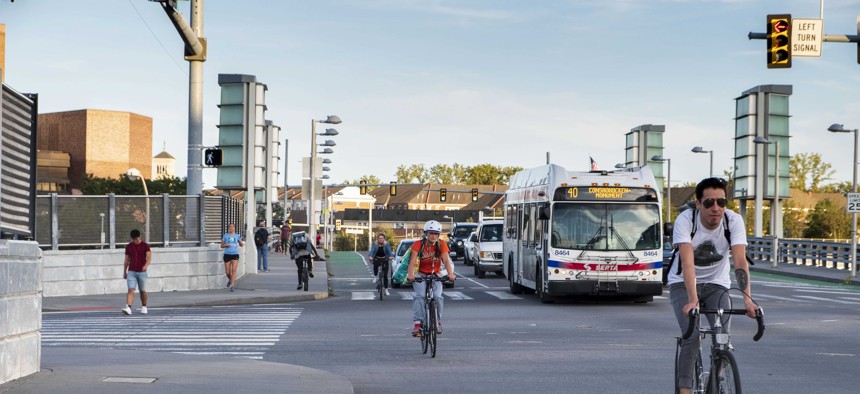To Bring Down Traffic Deaths, Feds Launch Another Safe Streets Initiative

Cyclists commuting on city streets bike lanes with cars and traffic in Philadelphia. Jumping Rocks/UCG/Universal Images Group via Getty Images
The Transportation Department has enlisted dozens of organizations that have committed to taking action to make the roads less dangerous.
With traffic deaths at “stubbornly high” levels, Transportation Secretary Pete Buttigieg launched an effort Friday to rally all corners of the transportation industry to work to make American streets safer.
“Crashes kill as many people in America as gun violence, and yet road safety gets less attention than so many other issues in transportation,” Buttigieg said in a video statement. “These road deaths are not inevitable, and every one of us has the power to do something about them.”
The federal transportation agency has enlisted dozens of organizations to support the safety initiative. Dubbed “Allies in Action,” it includes state transportation departments, Honda, Uber, Lyft, Lime, 3M, UPS, law enforcement, and groups of city officials. Each promised to take specific actions this year to make roads less dangerous.
The number of road deaths in the U.S. reached nearly 43,000 people in 2021, the latest year for which data is available. Those numbers rose dramatically in the early days of the pandemic, when streets were empty and reckless drivers had less traffic to slow them down. But they have remained at the higher levels, even after traffic has returned. Traffic fatalities are now at the highest levels in the last two decades.
Among the actions that the participants promised to take are:
- The Missouri Department of Transportation committed to expanding a 2017 public awareness campaign called, “Buckle Up, Phone Down.”. The agency came up with the initiative to counter the state’s weak traffic safety laws. Texting while driving is legal for adults in Missouri, and adults not wearing a seat belt is a secondary offense there, meaning police cannot pull over motorists for violating it.
- The National Association of City Transportation Officials said it would work with city planners and engineers in several ways, including offering a workshop on how to manage speed on arterial roadways, updating its design guide for bike infrastructure and for pushing for changes in the Manual on Uniform Traffic Control Devices to protect non-motorists.
- The National League of Cities pledged to expand training for city officials in smaller cities to apply for federal Safe Streets and Roads for All grants, improve local safety data and help elected officials work with youth safety advocates.
- The Vision Zero Network said it would develop tools to help cities better address equity concerns in their road safety improvements.
- The American Road & Transportation Builders Association promised to focus on work zone safety, including using speed cameras in work zones, improving communication between workers and preventing vehicles from entering construction areas.
- UPS committed to installing automatic emergency braking on new heavy-duty trucks, which uses sensors to slow a vehicle if they determine the truck is approaching an obstacle too quickly.
- The League of American Bicyclists promised to provide technical assistance to local governments and other stakeholders interested in addressing vulnerable road user safety.
- Lyft announced it would continue funding a partnership with the Governors Highway Safety Association to provide ride-hailing services during the holiday to prevent drunk driving. The company also said it would offer its drivers a feature that tells them when they are driving faster than 5 mph over the speed limit and gives them a weekly report on their driving behavior.
The full list is here.
The initiative comes one year after the Transportation Department released its National Roadway Safety Strategy, which called for a “safe systems” approach, much like the way the aviation industry handles flight safety. It required improvements throughout the transportation industry, including redundant systems that reduce the risk that one mistake would lead to crashes that kill or injure road users.
Earlier this week, the Federal Highway Administration awarded $800 million in safety grants for local governments. More than 500 projects across the country received funding. The FHWA also released a map showing the locations of fatal crashes between 2016 and 2020.
Daniel C. Vock is a senior reporter for Route Fifty based in Washington, D.C.
NEXT STORY: How to solve customer-service language barriers with virtual queuing






